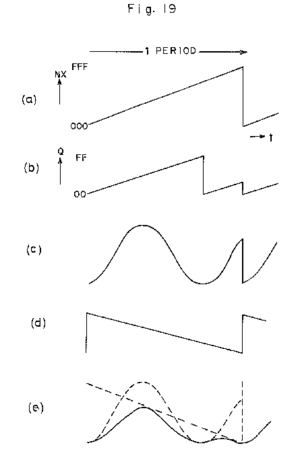Phase distortion synthesis
Phase distortion synthesis is a synthesis method introduced in 1984 by Casio in its CZ range of synthesizers, and similar to phase modulation synthesis in the sense that both methods dynamically change the harmonic content of a carrier waveform by application of another waveform (modulator) in the time domain. Casio introduced the term 'phase distortion'.
Casio's implementation of PD utilised a single modulating and carrier waveform, however, as the waveforms were composite, many harmonics were created in the resultant, output waveform. This is different from Yamaha's approach where only sine waves (single harmonics) could be used as carrier or modulator (either 4 or 6), though Yamaha did change this in later machines and allowed the use of composite waveforms such as sawtooth waves.
On the Casio machines the waveforms available for use were rich in harmonics such as a square wave. Other waveforms that are supported on the CZ range are impulse, half-sine and double impulse. The CZ synthesizers also generate synchronised and windowed sine waves in order to emulate resonant filter sweeps.

The phase transforms are all assembled from piecewise linear functions under binary logic control and shows characteristic sharp knees (and for some transforms, even sudden jumps) as they move from minimum to maximum, where the frequency counter's accumulator wraps around and starts over. The sharp knees are smoothened out by the roundness of the modulated sine wave and not too noticeable in the resulting signal.
Simulating a resonant filter
Figure 19 from the 1985 CZ-series patent shows how to emulate the variable resonance found in analogue voltage-controlled filters:
- (a) The base frequency counter, wrapping around every period.
- (b) The resonance frequency counter at a slightly higher frequency, being reset (or "synced") when the base counter wraps around.
- (c) The resonance frequency counter used as a sine wave readout. Note the nasty sudden jump at the reset!
- (d) The inverted base frequency counter.
- (e) Multiplying c by d. The sudden jump in c is now leveled out.
To summarize in other terms, the filter implementation is a form of digital hard sync, but adds a triangular descending volume envelope running within the sync period. Because the volume always ends at zero, the discontinuities that would cause aliasing in native digital hard sync are avoided. Filter sweep effects are generated in the same way that hard sync effects are generated: by modulating the frequency of the resonance waveform, the timbre changes, adding and subtracting harmonics as desired.
Casio made five different synthesizers using this method of phase distortion synthesis.
The VZ-1's synthesis method ("Interactive phase distortion") includes Frequency modulation synthesis as well as an improved version of phase distortion.
Comparison to other types of synthesis
Phase distortion applies similar mathematical concepts to phase modulation, although the results are not equivalent or necessarily translatable between the two types of synthesis. Yamaha had previously produced the first digital phase modulation synthesizers in their DX and related series of synthesizers, although the company promoted these synths as FM when the mathematical basis was phase modulation[citation needed]. However, phase modulation and frequency modulation can produce identical results for many parameter spaces, with phase modulation allowing higher stability and other benefits while still being capable of the same sounds as would 'traditional' frequency modulation (and others besides), so this was not really mis-branding. Secondary to the differing mathematical transformations, another cause of differences between PD and PM/FM synthesis are that famous PD synths such as Casio's range only have a single carrier and a single modulator per voice, whereas Yamaha's digital FM synths of the 1980s either had 4 or 6 oscillators, which Yamaha termed "operators". Single operators or multiple carrier/modulator pairs could be chained and/or run in parallel, which Yamaha termed an "algorithm".
